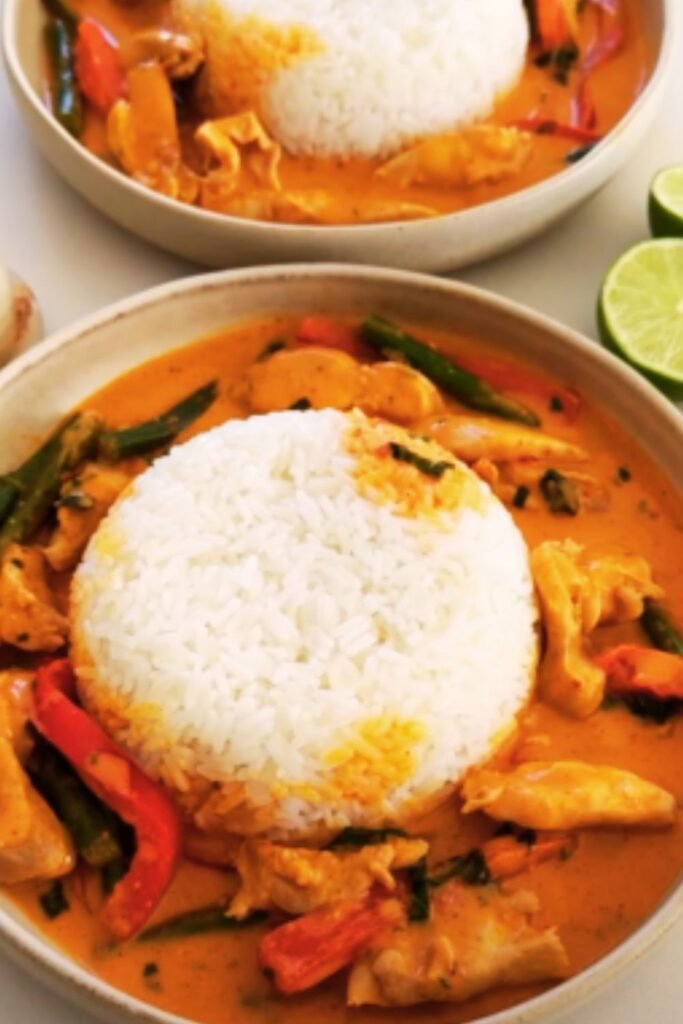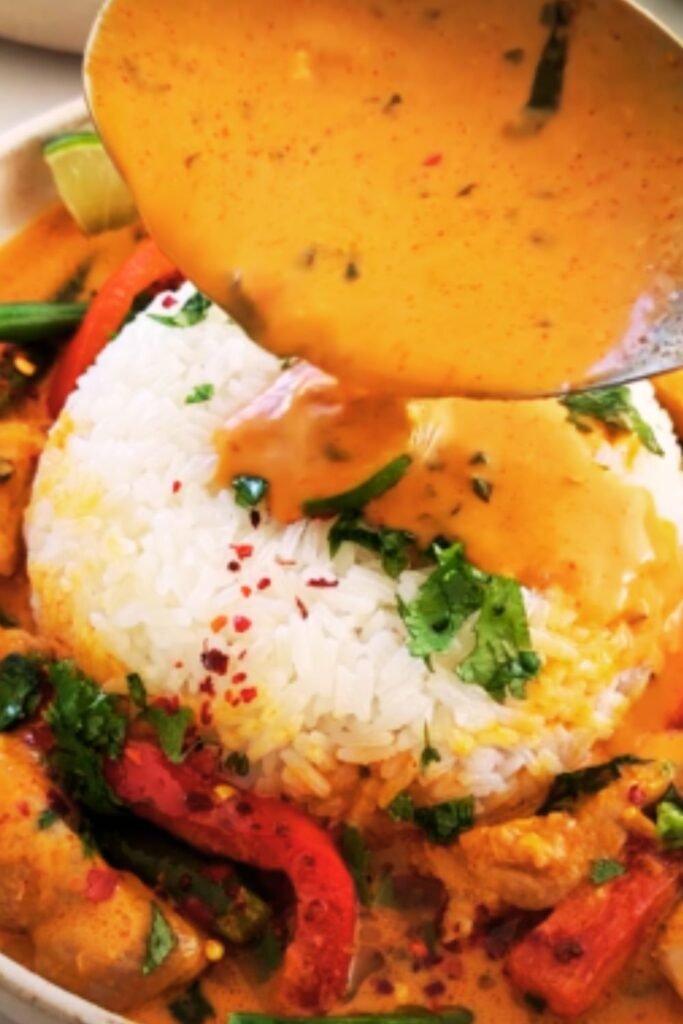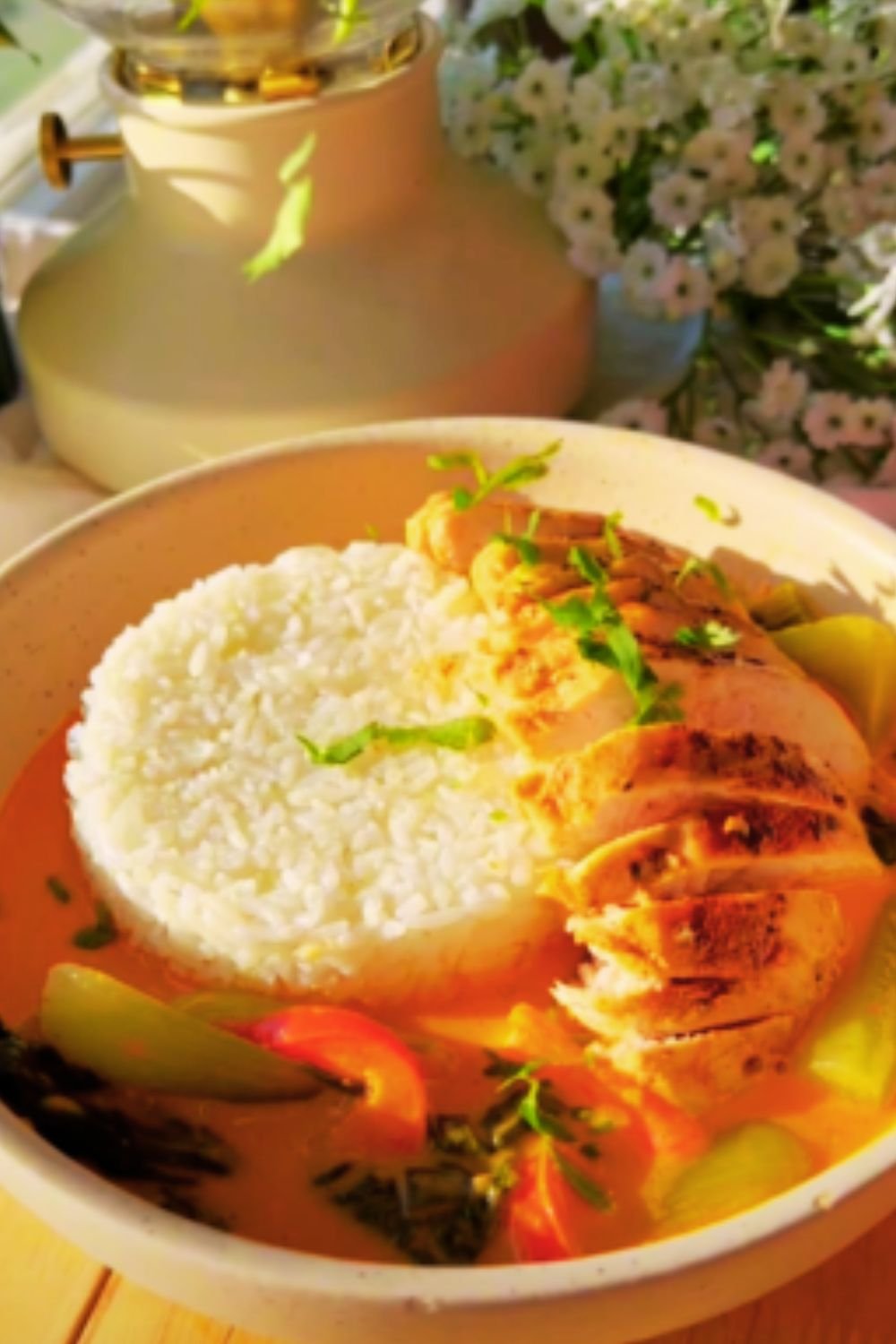There’s something magical about the moment when the aroma of Thai red curry starts wafting through your kitchen. As someone who’s been cooking Thai cuisine for over a decade, I can tell you that making an authentic-tasting Thai red curry chicken doesn’t have to be complicated. Today, I’m sharing my foolproof recipe that brings restaurant-quality Thai curry right to your dining table.
What Makes Thai Red Curry Special?
Thai red curry holds a special place in my heart. The harmonious blend of aromatic herbs, spices, and coconut milk creates a symphony of flavors that’s both comforting and exciting. While green curry might be sharper and yellower milder, red curry strikes the perfect balance between heat and complexity.

Essential Ingredients
Let me break down the key ingredients you’ll need:
For the Curry Base:
- 2 cans (14 oz each) full-fat coconut milk
- 3-4 tablespoons Thai red curry paste
- 2 tablespoons fish sauce
- 1 tablespoon palm sugar (or brown sugar)
- 4-5 kaffir lime leaves
- 2 tablespoons vegetable oil
- 1 stalk lemongrass, bruised and cut into 4-inch pieces
For the Chicken and Vegetables:
- 1.5 pounds boneless, skinless chicken thighs, cut into bite-sized pieces
- 1 red bell pepper, sliced
- 1 yellow bell pepper, sliced
- 1 cup bamboo shoots, drained
- 1 cup Thai eggplant (or regular eggplant), cut into chunks
- 1 cup Thai basil leaves
- 2 tablespoons freshly squeezed lime juice
Kitchen Equipment Needed
| Equipment | Purpose | Essential? |
|---|---|---|
| Large wok or deep skillet | Main cooking vessel | Yes |
| Sharp knife | Ingredient preparation | Yes |
| Cutting board | Prep work surface | Yes |
| Measuring spoons | Precise measurements | Yes |
| Can opener | Opening coconut milk | Yes |
| Wooden spoon | Stirring curry | Yes |
| Rice cooker or pot | Cooking rice | Yes |
| Small bowls | Ingredient organization | Optional |
| Microplane grater | Grating aromatics | Optional |
Step-by-Step Cooking Instructions
1. Preparation Phase (15 minutes)
First, let’s get everything organized. I’ve learned that mise en place is crucial for Thai cooking:
- Cut chicken into uniform 1-inch pieces
- Slice bell peppers into thin strips
- Prepare aromatics (lemongrass, lime leaves)
- Measure out curry paste and other seasonings

2. Creating the Curry Base (10 minutes)
- Heat vegetable oil in a large wok over medium heat
- Add curry paste and fry for 2-3 minutes until fragrant
- Slowly add 1 can of coconut milk, stirring constantly
- Add lemongrass and kaffir lime leaves
- Simmer for 5 minutes, stirring occasionally
3. Cooking the Curry (20 minutes)
- Add chicken pieces and cook for 5-7 minutes
- Pour in the second can of coconut milk
- Add fish sauce and palm sugar
- Add vegetables in order of cooking time:
- Eggplant first (5 minutes)
- Bell peppers and bamboo shoots (3-4 minutes)
- Thai basil leaves (last minute)
4. Finishing Touches (5 minutes)
- Taste and adjust seasonings
- Add lime juice
- Remove lemongrass pieces and lime leaves
- Let rest for 5 minutes before serving

Pro Tips from My Kitchen
After years of making this dish, I’ve discovered several tricks that make a huge difference:
- Don’t shake the coconut milk cans before opening. The separated cream at the top is perfect for frying the curry paste.
- Fry the curry paste until you see oil separating – this is called “breaking” the curry and intensifies the flavors.
- Use chicken thighs instead of breast meat – they stay juicier and more flavorful.
- Don’t skip the fish sauce – it’s crucial for achieving that authentic Thai taste.
- Add harder vegetables first, followed by softer ones to ensure proper cooking times.
Troubleshooting Common Issues
| Problem | Cause | Solution |
|---|---|---|
| Curry is too thin | Too much liquid added | Simmer longer to reduce |
| Curry is too spicy | Too much curry paste | Add more coconut milk |
| Chicken is tough | Overcooked or cut too small | Cut larger pieces, cook less |
| Sauce is bland | Insufficient seasoning | Add more fish sauce or salt |
| Vegetables are mushy | Added too early | Add in proper sequence |
Serving Suggestions
I love serving this curry with:
- Jasmine rice (traditional)
- Coconut rice (for special occasions)
- Fresh cucumber slices
- Extra lime wedges
- Crispy shallots for garnish
- Fresh cilantro leaves
Storage and Reheating
The curry actually tastes better the next day! Store it in an airtight container in the refrigerator for up to 3 days. When reheating, add a splash of coconut milk or water to achieve the desired consistency.
Health and Dietary Considerations
| Nutrient | Amount per Serving |
|---|---|
| Calories | 450 |
| Protein | 28g |
| Fat | 32g |
| Carbohydrates | 15g |
| Fiber | 3g |
| Sodium | 890mg |
Recipe Variations
- Vegetarian Version:
- Replace chicken with tofu or mixed vegetables
- Use soy sauce instead of fish sauce
- Add mushrooms for extra umami
- Seafood Version:
- Substitute chicken with shrimp or mixed seafood
- Reduce cooking time accordingly
- Add a touch of lime zest
- Low-Carb Option:
- Serve with cauliflower rice
- Add extra vegetables
- Use sugar substitute instead of palm sugar
Questions & Answers
Q: Can I make this curry ahead of time?
A: Yes! It actually tastes better the next day as the flavors develop further. Store in the refrigerator for up to 3 days.
Q: Is there a substitute for kaffir lime leaves?
A: While not exactly the same, you can use lime zest mixed with a bay leaf for a similar aromatic effect.
Q: How can I make the curry less spicy?
A: Use less curry paste and add more coconut milk. You can also serve it with cucumber slices to help cool things down.
Q: Can I freeze this curry?
A: Yes, but freeze it without the vegetables as they can become mushy. Add fresh vegetables when reheating.
Q: What’s the best brand of curry paste to use?
A: I recommend Mae Ploy or Maesri brands for authentic flavor. They’re available in most Asian grocery stores.
Cultural Context
Thai red curry, or “Gaeng Phed” in Thai, has been a staple of Thai cuisine for centuries. Originally, the curry paste was made by hand using a mortar and pestle, a practice still common in many Thai households today. The recipe has evolved over time, but the core combination of chili peppers, lemongrass, galangal, and shrimp paste remains unchanged.
I find it fascinating how this dish represents the perfect balance of Thai cuisine’s four fundamental flavors: spicy from chilies, salty from fish sauce, sweet from palm sugar, and sour from lime juice. This harmonious blend is what makes Thai red curry not just a meal, but an experience that tells the story of Thailand’s rich culinary heritage.
Remember, cooking Thai food is about finding your own perfect balance of flavors. Don’t be afraid to adjust the seasonings to suit your taste. With practice, you’ll develop an intuition for the right proportions, and before you know it, you’ll be making Thai red curry chicken that rivals your favorite restaurant’s version.


